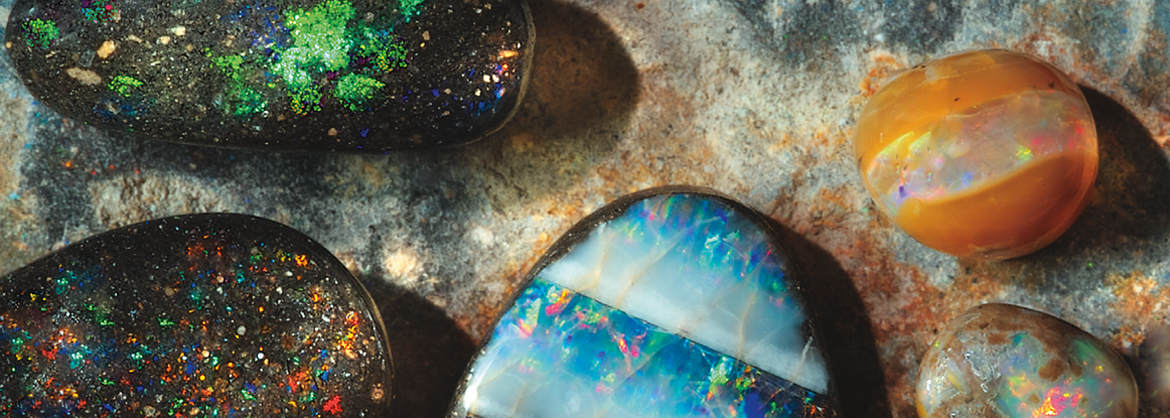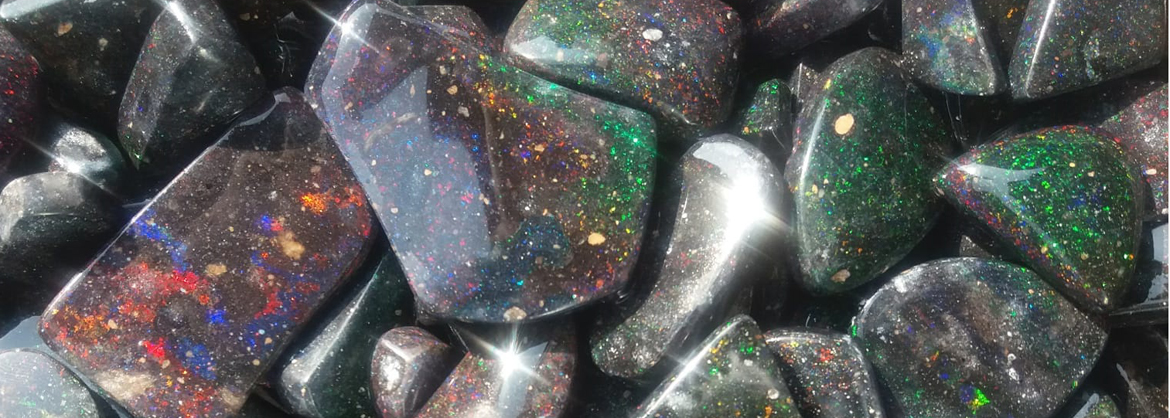
Honduras Opal - Meaning and Effect
Honduras opal gives us the just in the dark season sometimes missing hope and zest for life. The stone intensifies the he-life and he-feeling and thus stimulates imagination and creativity - the dark colors of nature are complemented by vivid, colorful inner images. As a strong spiritual protection stone, Honduras opal can protect us from unwanted external influences so that we can focus on our inherent powers.
You can find items made of Honduras opal and other popular opals here in our web store.
Mineralogical profile of Hondurian opal
Chemical Formula: SiO2
Mineral Class: Oxides, contains water in crystal
Origin: primarily from silica solutions in ignimbrites, ie. rocks formed from hot volcanic ash
Color: mostly black, rarely white or colorless; always with variegated opalescence
Gloss: vitreous luster, fatty luster, or matte
Crystal system: amorphous
Mohs hardness: 6 to 7
Splitness, fracture: no splitting, conchoidal to uneven fracture
Source, main supplying countries: Lempira /Honduras
Appearance: mostly in the rock finely distributed Black Opal ("Matrix Opal"), rarer snow-white veins with brightly colored Precious Opal ("Veta Opal"), very rarely water clear Precious Opal ("Crystal Opal") in small cavity fillings
Use: The opals from Honduras are mainly used as a jewelry stone, eg.E.g. cabochon, drilled stone part or pendant.
The gemstone astrology uses Honduras black opal to mobilize the regenerative power of Scorpio-born and to awaken zest for life in Capricorn-born. The white Veta Opal supports the spontaneity of Aquarius-born, crystal opal the unity striving of Pisces-born.
The name "Opal" comes from the ancient Indian "upala", in German "Edelstein", but the name already existed in ancient Greece ("opallios") and Rome ("opalus"). In Greek mythology, Edelopal originated from Zeus' tears of happiness after defeating the Titans. In India, it is considered the goddess of the rainbow turned to stone while fleeing from importunate gods.


Fair Trade Minerals
The Honduras opal promoted by the Verein Fair Trade Gems & Minerals e.V. has only been on the market for a few years, but is increasingly popular as a jewelry stone. On January 11, 2017, Marco Schreier Mineralienhandluing GmbH together with Michael Gienger GmbH at the start of the celebrations for the 20th anniversary of the seminar center Im Osterholz was able to present this project to the general public, which for Michael Gienger and also for Marco Schreier were and are heartfelt concerns: helping people to help themselves and the development of fair structures in the gemstone trade, while preserving opportunities for the local communities. The Honduras project is the important initiative in the legacy of Michael Gienger, the idea giver and co-founder. Beginning in 2008 with the establishment of the Opal Prospecting Cooperatives in Honduras, the jointly supported and funded project developed rapidly. Read more about the intiative and its beginnings on the website of the association. The project was also successfully advanced by numerous and regular donations from customers of Marco Schreier Mineralienhandlung GmbH and other additions by the company - more information here.
Formation of Honduras opal
Honduras opal is primarily formed from silica solutions in ignimbrites, i.e. rocks formed from hot volcanic ash, and belongs to the noble opals. In addition, it is a representative of the black opals rather rarely occurring on earth due to the mostly black matrix of the parent rock. Findings in Honduras with flat opal layers are also called Veta Opals, matrix opal is mostly in the rock finely distributed black opal. Very rarely one finds water clear precious opal ("crystal opal") in small cavity fillings. In general, it is the case with all opal varieties that the silica available does not form crystals, but rather a droplet-shaped gel in which liquid, usually water, is enclosed between the silica globules. Due to the refraction of light on these globules, opal then acquires its typical, usually intense play of colors. Depending on the matrix in which the opal is located, an opal is then called light opal, dark opal or black opal. Boulder Opals are rocks crisscrossed by gem opal veins. Common opals are opals with none, while gem opals have distinct, vivid shimmer in all colors of the rainbow. A special feature are the Fire Opals from Mexico, which show a uniform transparent color without color play and still belong to the noble opals.
